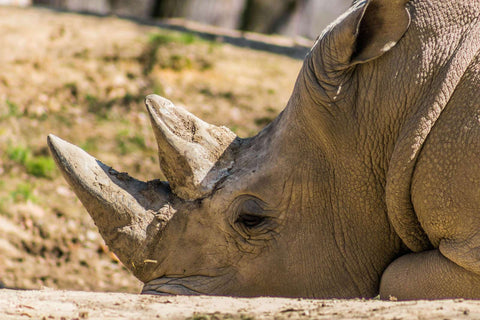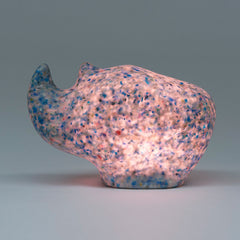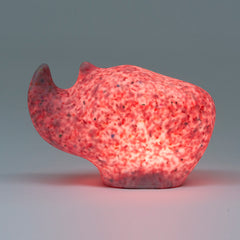ecoBirdy’s lamp shape resembles a rhinoceros. Casting a soft glowing light, this home accessory aims to raise awareness, not only of sustainability, but also of this endangered species. But why did Vanessa Yuan and Joris Vanbriel, the creative minds behind ecoBirdy, choose the symbolic shape of a rhinoceros for their meaningful design? And why is it important that we shed light on the situation of these endangered creatures?
Rhinoceros’ crucial role in ecosystems
As a part of the Big Five, rhinos represent an iconic animal species of our beautiful world, and that’s not the only reason we worry about their extinction. They are a ‘keystone species’ whose presence and role within ecosystems has a profound effect on other organisms within the system.
Rhinos play this crucial role primarily because of their position as mega-herbivores. By eating plants, they help reshape the surrounding land, spread nutrients for other animals with their dung, create short-grass ‘lawns’ for the benefit of plants and are a host to ectoparasites.
Rhinos are gentle beings that harmoniously coexist with other species, enriching ecosystems simply by being themselves.
Human impact on their extinction
Changes in land use and vegetation have resulted in rhinos living in isolated, fragmented groups, making it harder for them to reproduce and have a healthy genetic pool. In recent years, logging, agriculture and changes in grassland composition have increased in rhinos living environments in Africa and Asia. With the purpose of economic growth for humans, but simultaneously causing habitat loss for the local wildlife.
Another way humans pose a threat to rhinos is by poaching. On average, a rhino is poached every 15 hours. As the demand for rhino horns remains high, people keep hunting rhino’s to obtain their remarkable features. Which is a shame, considering the trade of the valuable horns (for illegal gifts or medicines) is one of the main reasons the animal is endangered.

Saving rhinos
Today only around 27,431 rhinos remain in the wild. Three species of rhino—black, Javan, and Sumatran—are critically endangered. According to WWF, there are several reasons causing their extinction, being habitat loss, poaching, and illegal wildlife trade.
In the face of its extinction, it is our responsibility to stand as guardians of these remarkable species.
The organization Save the Rhino focuses on protecting rhino, reducing illegal horn trade, involving communities and bringing experts together.
Through awareness, advocacy, and action, we can ensure that the rhinoceros lives on, a tribute to the long-term beauty and importance of biodiversity on our planet. The significance of these creatures in our world is tremendous. Beyond their symbolic representation in our Rhino Lamp design, rhinos stand as living relics of our planet's past. For millions of years, they have roamed the Earth.

Wildlife photo credits: Mariano Sokal
Sources:
https://www.wnypapers.com/news/article/featured/2021/05/01/146430/why-the-rhino-matters
https://africageographic.com/stories/why-are-rhinos-important-for-ecosystems/
https://worldanimalfoundation.org/advocate/poaching-statistics/
https://rhinos.org/about-rhinos/state-of-the-rhino/
Header image credits: Andrew Liu.



